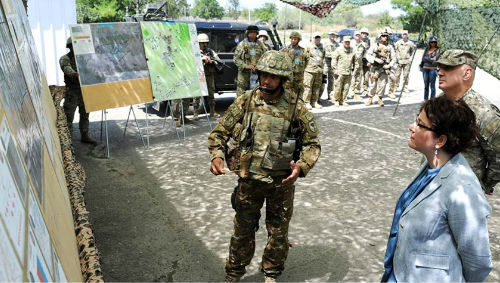| Defense Minister: ‘Russia Tests Our Patience’ |
| Civil Georgia, Tbilisi / 19 Jul.'15 / 19:40 |

Defense Minister, Tina Khidasheli, visiting Agile Spirit 2015 multinational military exercises at the Vaziani military base outside Tbilisi, July 19, 2015. Photo: Georgian MoD
Placing of demarcation signposts along the breakaway South Ossetian administrative boundary line is part of Russia’s provocations through which it is “testing our patience,” Georgia’s Defense Minister Tina Khidasheli said on July 19.
“The goal is not to make the country victim of provocations, which Russia is permanently undertaking against us,” she said.
“By doing this they are testing our patience on the daily basis, trying to provoke and engage us in the conflict, which, I can assure you, Georgia’s current authorities will not let happen,” she told journalists at the Vaziani military base outside Tbilisi, where Agile Spirit 2015 drills are held with participation of Georgian, U.S., Bulgarian, Latvian, Lithuanian and Romanian troops.
Signposts marking “South Ossetian border” were placed on July 10 close to the villages of Tsitelubani and Orchosani in the short distance from Georgia’s main east-west highway and in the area where a mile-long portion of the BP-operated Baku-Supsa oil pipeline runs.
Series of protest rallies by activists and journalists, who were arriving in the area from Tbilisi followed, with one of the signposts being torn down. Some locals were complaining that those protests were exacerbating situation, affecting further negatively on the local population living in an immediate vicinity of the administrative border. Police restricted access to the area on July 17 for non-local residents. A protest rally, organized by some media outlets and civil society organizations, was held in Tbilisi on July 18, criticizing government’s policies towards Russia and accusing the authorities of not doing enough to prevent Russia’s “creeping occupation.”
After the August, 2008 war and following recognition of South Ossetia’s “independence” by Moscow, Russian forces in the breakaway region started building demarcation line mostly along southwestern, south and southeastern portions of the administrative border. The line mostly follows the Soviet-old administrative borders of former Autonomous District of South Ossetia

Barbed wire fence in the village of Akhali Khurvaleti on the administrative boundary line of breakaway South Ossetia. Photo: Monica Ellena
The process, referred as “borderization”, involved placing of border markers, erecting of fences and putting barbed wires, cutting farmlands and in some cases dividing villages.
In September, 2010 when one of the early instances of borderization affected farmlands close to the villages of Kvemo Nikozi, Zemo Nikozi, Ditsi, Arbo and Kordi, the Georgian authorities initially started vocal protest, but toned down rhetoric shortly afterwards.
Borderization process was stepped up in the course of 2013 with the dividing fences reaching the length of roughly 45 kilometers by the end of that year.
Currently there are about 200 “border” signposts along the administrative boundary line, according to EU Monitoring Mission in Georgia (EUMM), whose unarmed monitors observe situation on the ground since the 2008 war; but they have no access to breakaway South Ossetia and Abkhazia.
Head of the EUMM, Lithuanian diplomat Kęstutis Jankauskas, said in an interview with the Georgian public broadcaster on July 16 that this year “we have not seen much borderization activities.”
He said that the recent installation of demarcation signposts were made in close vicinity of strategic infrastructure, including Georgia’s main east-west highway, and “in these issues there are lots of emotions”
“In terms of perceptions these signs for the local population mark the areas where they can or where they cannot go, so for them the boundaries have moved and that’s why it’s so emotional,” he said.
A meeting of Incident Prevention and Response Mechanism (IPRM) has been scheduled for July 20 to address recent developments. IPRM represents meetings with EUMM facilitation between Georgian and South Ossetian representatives, as well as representatives of the Russian troops on the ground.
